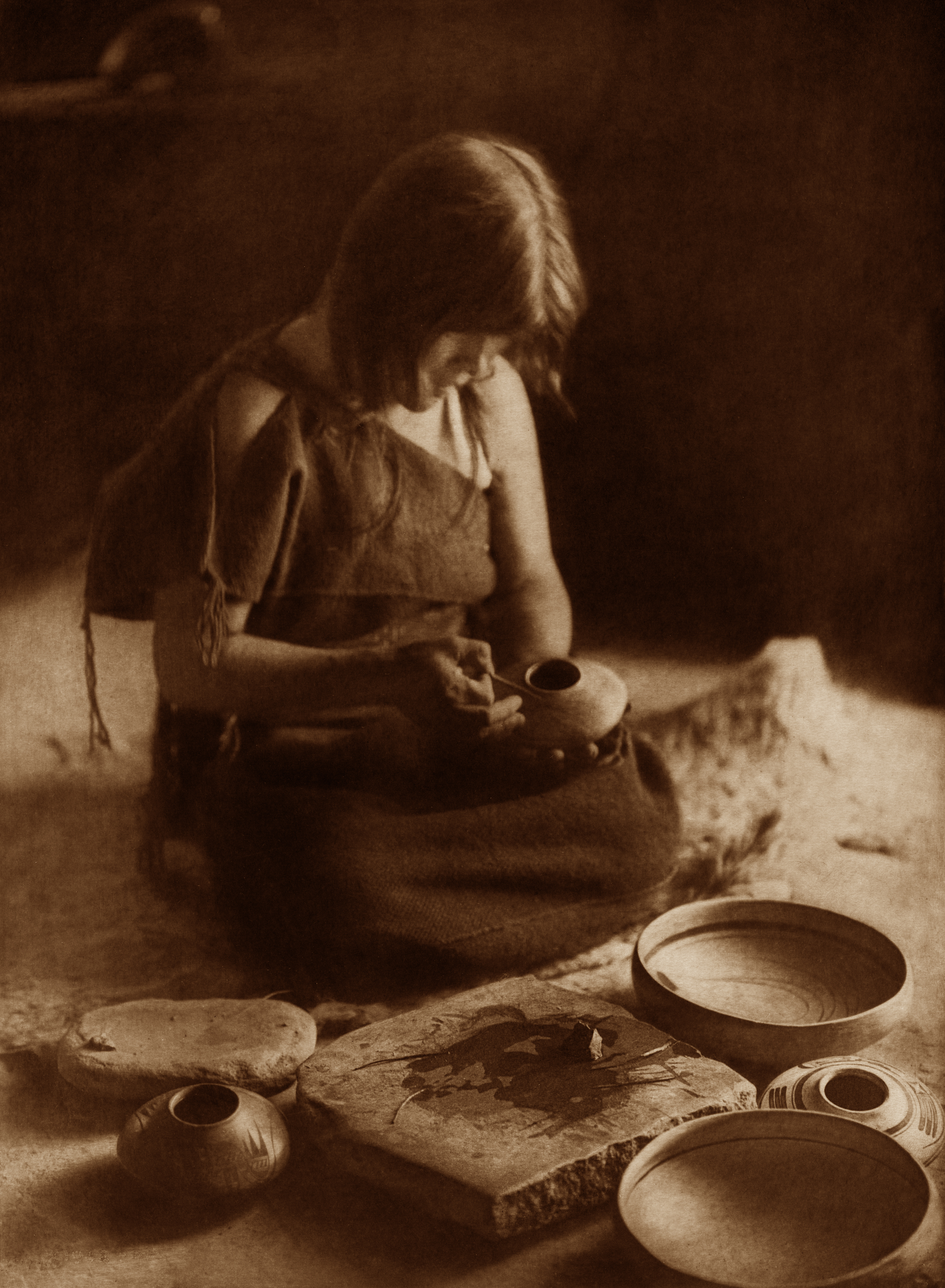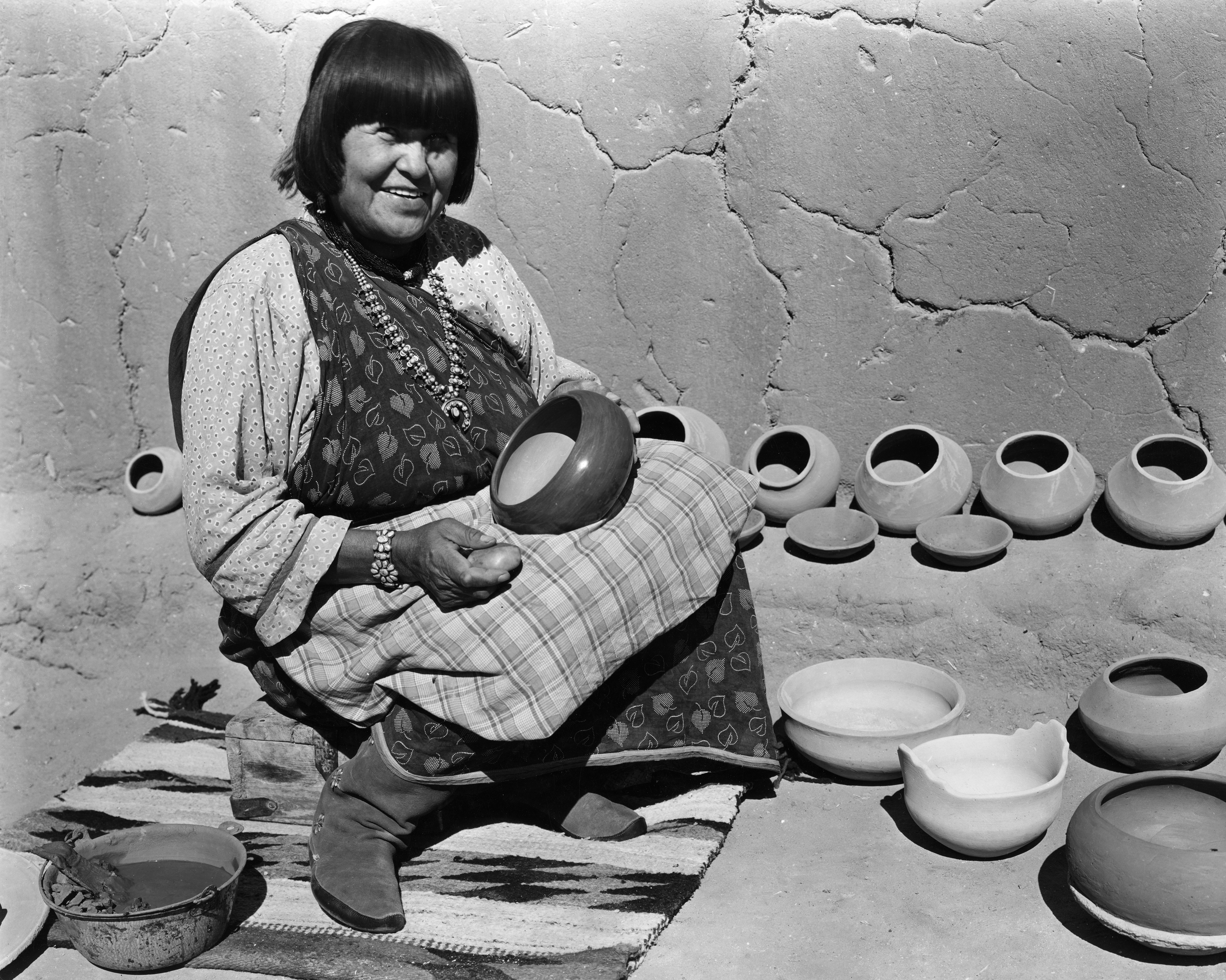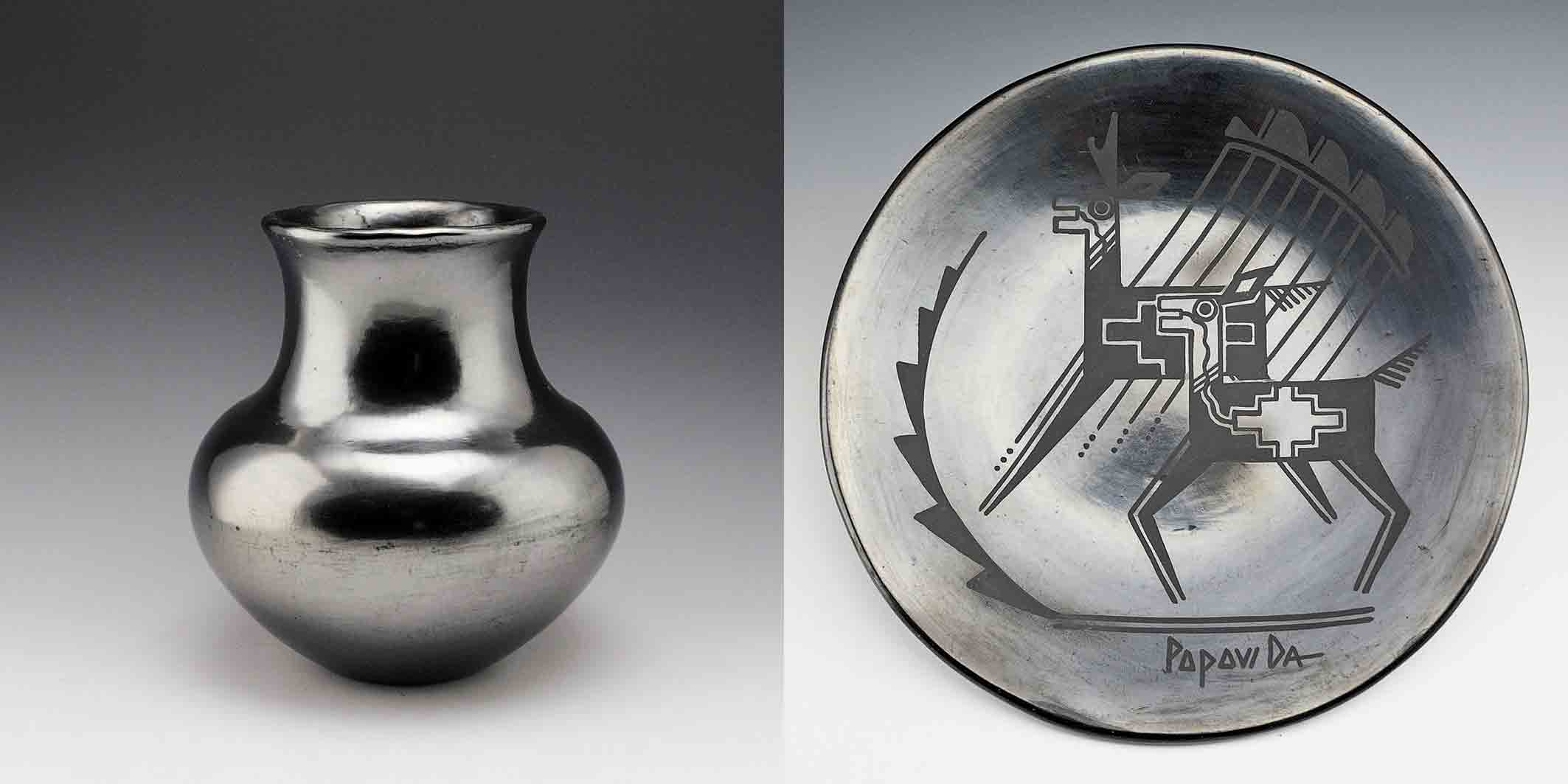Historic potters opened doors for generations of artists.
For two of the most influential Southwest Native American potters of the past 120 years, there was no such thing as proprietary knowledge, or keeping all the glory for themselves. Each of these two women used her spirit of experimentation and extraordinary artistic talent in ways that revitalized the ancient craft of pottery and lifted it to the level of fine art. Yet both also freely and generously encouraged others to create work like theirs, as a means of making a living at a time when there were few such options. In doing so, they opened doors for generations of ceramic artists, in their own families and beyond.
One was the Hopi/Tewa potter known simply as Nampeyo, who lived from around 1860 to 1942 — there is no official record of her birth year. The other was Maria Martinez of San Ildefonso Pueblo, north of Santa Fe, whose long, productive life spanned almost a century, from 1887 to 1980. “Their pottery was beautiful, but they considered themselves just potters from their communities and wanted to share what they had learned. And they were both amazing teachers,” says Shelby J. Tisdale, director of the Center of Southwest Studies at Fort Lewis College in Durango, Colorado. As a scholar and former director of the Museum of Indian Arts and Culture in Santa Fe, Tisdale has studied the legacies and lineages of the two potters and their remarkable accomplishments.
Nampeyo
Nampeyo, of Hopi and Tewa ancestry, grew up in the village of Hano on the Hopi Reservation’s First Mesa in northeastern Arizona. She learned pottery making as a girl, probably from her paternal grandmother, Tisdale says. Married at around age 20 to a Hopi farmer named Lesou, she became fascinated with the designs on ancient pottery shards she and Lesou came across, many from the ruins of the former village of Sikyatki, not far from Hano. She began reproducing elements of the old designs on her own pots, which she sold at the nearby Keams Canyon trading post.

The North American Indian/courtesy christopher cardoza fine art
Sikyatki polychrome, also called yellow ware, was produced from about 1325 to 1630 at Sikyatki and two other Hopi villages. It was made with fine local clay that polished to a smooth, hard surface and represented a high watermark in known Hopi pottery prior to the turn of the 20th century. When Nampeyo began making pottery, the predominant style was what is now referred to as Polacca polychrome. Produced with coarse clay, it required a thin layer of finer clay applied to the surface, on which to paint designs. The white surface layer, or slip, often cracked over time and was not as aesthetically pleasing as the earlier, Sikyatki style.
In 1895, anthropologist Jesse Fewkes led an archaeological excavation of Sikyatki village, unearthing large quantities of pottery shards and whole vessels. Fewkes later claimed credit for introducing Nampeyo to Sikyatki pottery shards, but Tisdale and other scholars believe the potter was incorporating the ancient designs before meeting Fewkes.
In 1898 Nampeyo and Lesou traveled to Chicago to exhibit her pottery, and in 1905 and 1907 she demonstrated pottery making and sold her vessels at the Fred Harvey-operated Hopi House, a tourist attraction on the rim of the Grand Canyon. “She was the first Indian artist to be recognized by the American public as an individual artist, not just an Indian woman making pottery. She just stood out,” Tisdale says.
Nampeyo loved to experiment, and by 1903 she was starting to reproduce not only her ancestors’ designs but their methods and materials as well. By carefully studying the ancient pottery, she discovered how these earlier Hopi ancestors produced their beautiful yellow ware. Perfecting and sharing her knowledge with her three daughters and other local potters — all of whom would go on to teach these methods to others — Nampeyo became known for initiating a revival of the ancient art form of Sikyatki polychrome.
Nampeyo’s daughters — Annie, Nellie, and Fannie — all became talented potters. Along with Lesou, they assisted their mother in painting her designs, especially after Nampeyo began losing her eyesight in the early 1920s. Her daughters passed their mastery of yellow ware down to their own daughters, including the exceptionally skilled Daisy Hooee Nampeyo, Annie’s daughter.
Today the extraordinary quality encouraged by Nampeyo continues, even as artists incorporate their own designs and many have moved in contemporary directions. Nampeyo’s great-granddaughter, Dextra Quotskuyva Nampeyo, has been influential, known not only for her creations but also for helping open up to men what was traditionally a woman’s art form. Among the award-winning male Hopi/Tewa potters today: Dextra’s nephew, Les Namingha; Annie’s great-grandson, Steve Lucas; Loren Ami, who learned from Dextra; and contemporary potter Preston Duwyenie. “Nampeyo’s revival style,” Tisdale says, “became the hallmark of later Hopi pottery.”
Maria
Maria Montoya Martinez, perhaps the most famous of all New Mexico Pueblo potters, became known around the world during her lifetime — also by a single name, Maria. Born in 1887 and living her entire life at San Ildefonso Pueblo, she is credited, with the help of her husband, Julian, with reviving the 17th-century San Ildefonso art of highly burnished blackware. Maria’s black-on-black pottery became immensely popular beginning in the early 1920s and continues to set the bar for quality and aesthetic standards.
For the modest, unassuming potter, the result was widespread recognition, including top awards at Santa Fe Indian Market (established in 1922), honorary university degrees, a 1973 National Endowment for the Arts grant, and invitations to the White House by four different presidents. Yet in the spirit of community sharing that marks traditional Pueblo life, Maria continuously taught and encouraged others from San Ildefonso and elsewhere to use the methods she and Julian painstakingly perfected.

When Maria was a child, her pueblo’s tradition of polished blackware (also made at Santa Clara Pueblo) had been lost over time. Instead San Ildefonso potters were producing polychrome ware. She learned to work with clay primarily from her aunt, Nicolasa Peña Montoya, whose high level of skill brought out her niece’s innate talent. Maria soon became known for the uncommonly fine quality of her vessels. “She was excellent at forming her pottery — whether plates, bowls, or jars, they were all beautifully executed and well-balanced. She made wonderfully fine pottery,” Tisdale says.
Julian Martinez was a San Ildefonso watercolor painter whose talents had been encouraged by Dr. Edgar Lee Hewett, founder and director of the Museum of New Mexico in Santa Fe. Along with other Anglo-American artists and intellectuals at the time, Hewett had a keen interest in helping Pueblo people revive lost arts and improve the quality of their creations. Maria didn’t paint her own pottery, and when she and Julian married in 1904, he transferred his strong sense of artistic design and steady hand to painting designs on her polychrome pots.
The couple’s efforts shifted after 1908, when shards of black-on-cream biscuit ware were discovered during an archaeological excavation led by Dr. Hewett, who was also an archaeologist and anthropologist. Aware of Maria’s reputation as a potter, Hewett encouraged her to re-create, on her own pottery, the ancestral designs found on the black-on-cream biscuit ware. Maria and Julian responded by reproducing the ancient designs on various pottery forms.
By 1912 the couple had begun making plain polished black pottery by experimenting with a firing technique, done in a traditional Pueblo outdoor fire pit or handmade kiln, that transformed red clay pots to deep black. The method reduces the oxygen during firing by partially smothering the flames with pieces of broken pottery and dried cow or horse dung. The resulting cooler firing temperature causes the pots to turn black. Through trial and error, Maria and Julian also learned to produce black-on-black ware, which features matte black designs on polished black pots.
Yet before Julian decorated and helped fire Maria’s pots, she spent weeks or months making them — preparing the clay that she and her family gathered, forming elegantly shaped vessels, and polishing them through countless precise strokes with a rounded polishing stone. “The high polish, or gloss, Maria achieved by rubbing a stone across the surface of a clay pot is absolutely mind-blowing,” Tisdale says.

Julian and Maria worked together on her pottery until Julian’s death in 1943, after which their son Adam’s wife, Santana, helped paint Maria’s pottery; later, so did their other son, Popovi Da. Da was an unusually talented artist who later created his own pottery, becoming the first contemporary Pueblo ceramic artist to inlay his vessels with turquoise. Popovi and wife Anita Da’s son, Tony Da, continued his father’s innovation of adorning pottery with inlay, adding turquoise, wrought silver, and shell beads.
Other San Ildefonso Pueblo potters who carried on Maria’s legacy of exceptional quality included Blue Corn (Crucita Calabaza), and Rose Cata Gonzales of San Juan Pueblo, who married a San Ildefonso man and became known for introducing deep carved pottery to San Ildefonso. Among the Pueblo’s many outstanding present-day clay artists — some working in polychrome and other styles — are Maria’s great-granddaughter Barbara Gonzales; Barbara’s son, Cavan Gonzales; and Rose Gonzales’ great-nephew Russell Sanchez. Each of these and countless others ultimately owe their place in the pottery world to the groundbreaking efforts of Nampeyo and Maria, Tisdale says. “They elevated what had been previously perceived as a craft, to an art form.”
From the August/September 2018 issue.
More From The August/September 2018 Issue
25 Things That Shaped The Western
Bridges On Birmingham
The Iroquois White Corn Project













